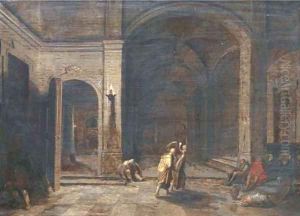Hendrick Van Steenwijk Paintings
Hendrick van Steenwijck the Younger was a Flemish painter who specialized in architectural interiors of churches and cathedrals. Born around 1580 in Antwerp, he was part of a family of artists, with his father Hendrick van Steenwijck the Elder also being a notable painter of similar subjects. Steenwijck the Younger's work is characterized by the use of perspective to create depth and the meticulous rendering of architectural details, which often included Gothic or Renaissance buildings.
Steenwijck moved to London in the early 17th century, where he became associated with the court of King James I. His move to London was likely influenced by the success of his father in the same city, where the elder Steenwijck had worked at the court of Queen Elizabeth I. In England, Hendrick the Younger continued to paint his architectural subjects, and he also collaborated with other artists, such as Anthony van Dyck and Peter Paul Rubens, adding architectural backgrounds to their figure compositions.
His work is known for its precise linear perspective, which he used to create an illusion of space and depth, and for the skillful use of light and shadow, which added a sense of drama to his interior scenes. Van Steenwijck's paintings often included figures, although these were typically not the primary focus of the composition. His interiors of cathedrals and churches reflect an interest in the contrast between the vast architectural spaces and the human figures inhabiting them.
After a successful career in London, Hendrick van Steenwijck the Younger moved to the Dutch Republic, where he continued to work and influence other artists in the genre of architectural painting. He died in Leiden in 1649. His works can be found in numerous museum collections, including the National Gallery in London, and continue to be studied for their contribution to the development of architectural painting in the early modern period.
